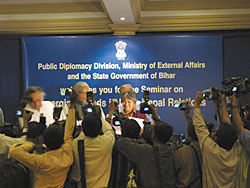|
|
| MEDIA FRENZY: Hisila Yami is mobbed by Indian media in Patna on Saturday. with her on the podium is Bihar chief minister Nitish Kumar and State Minister for Commerce, Jairam Ramesh. |
Initially caught off-guard by Nepal's constituent assembly election results, New Delhi is hoping to do business with a Maoist-led government especially on water resources.
Publicly, the Indians say they are happy with whatever result, but there seems to be nervousness about Maoist policy on strategic issues like water, power and geopolitics.
"Some people seem to think we were caught by surprise with the result," says Shyam Saran, former ambassador to Kathmandu and ex-Foreign Secretary, "but India doesn't play favourites in Nepal. We can do business with any political dispensation."
But past Maoist pronouncements, including an interview by Pushpa Kamal Dahal in 2000 in which he boasted the Maoists would fight the Indian Army if necessary and frequent references to "Indian expansionism" in Dahal's campaign speeches haven't helped allay Indian unease.
When the Maoists won the election, the Indian Ministry of External Affairs nearly cancelled a previously-scheduled conference here in the Bihar capital to discuss Indo-Nepal relations. Even though some high-profile guests and speakers dropped out, the meeting went ahead as scheduled on 26-27 April.
Saran and Indian State Minister for Commerce and Power Jairam Ramesh stayed for the whole two-day conference attended by 40 invited participants from Nepal. The Nepali delegation was headed by Minister for Physical Planning and Infrastructure, Hisila Yami, and also included Maoist leader CP Gajurel.
Bihar is suffering a crippling power shortage this summer, and the Ganges is almost dry. But in a few months, as every year, most of the state will be inundated by floods. It wasn't surprising, therefore, that a recurrent theme at the conference was water and power.
"In Bihar we only think of Nepal during the monsoon floods," quipped Nitish Kumar, Bihar's chief minister in his keynote address. "We have a common problem of poverty and we can tackle that by mutual cooperation on the Kosi High Dam." How to deal with displacement of people in Nepal and the Kosi\'s massive silt load was not broached.
Yami didn't want to be dragged into specifics, but responded: "People on both sides of the border would benefit from transparency and accountability in political and economic commitments... particularly in the areas of flood control."
Kumar saw storing monsoon runoff on Himalayan high dams as mutually beneficial. But given perceptions of unfair treatment on Kosi and Gandaki in the 1960s, India may need to do more to build trust among Nepalis about river sharing. It didn't help that Indian officials kept urging Nepal to follow the "Bhutan model".
In the past six months two Indian private companies have signed MoUs for the 300MW Upper Karnali and 400MW Arun III. Adding West Seti and Budi Gandaki, the total power agreement with India would go up to nearly 1,800MW.
Minister Ramesh was optimistic that all this would lead to bigger and better things. "We are no longer talking about a pie in the sky," he said, "we have made progress and a final push on joint projects by the new government is all that is required."
Ramesh tried to assure Nepali visitors that India was not "coveting and salivating" over Himalayan rivers, but would like to see mutual cooperation also benefit Nepal with power, irrigation and balance of payments. "One major project exporting power to India would wipe out Nepal's trade deficit with India," he said.
Saran echoed the view. "Nepal has to start seeing India not as a threat but as an opportunity, you are next door to a country of one billion growing at eight percent with which you have an open border," he said, "Nepal is not India-locked, it is India-open."
Participants said India-Nepal economic cooperation has suffered because Nepali nationalism is often defined by anti-Indianism. Former JNU professor S D Muni advised the Maoists not to fall into that trap. "The new rulers of Nepal don't have to fall back on that nationalist agenda, and India shouldn't try to play pawns and bishops in Nepal."
Seven years ago when India's Power Trading Corporation's Tantra Naryan Thakur came to Nepal to explore electricity import prospects, he remembers Nepali officials assuring him that Nepal could export 150MW by 2007. "Today, Nepal is buying power from India," Thakur told the conference.
But he said India's demand for power would grow to 200,000 MW by 2018. If Nepal could fast-track projects to generate just 10,000MW in ten years, consume 2,000MW itself and export the rest to India it could earn $2.7 billion a year, Thakur said.
Foreign investors in Nepal, however, say they need to feel that they are not wasting their time. Dabur India is one investor which has stuck it out in Nepal through the conflict years. Its CEO, Udayan Ganguly said: "Nepal needs to create the right atmosphere for investors by resolving labour issues, violence and insecurity. Unless swift action is taken, the few investors that remain may decide it's not worth it."



